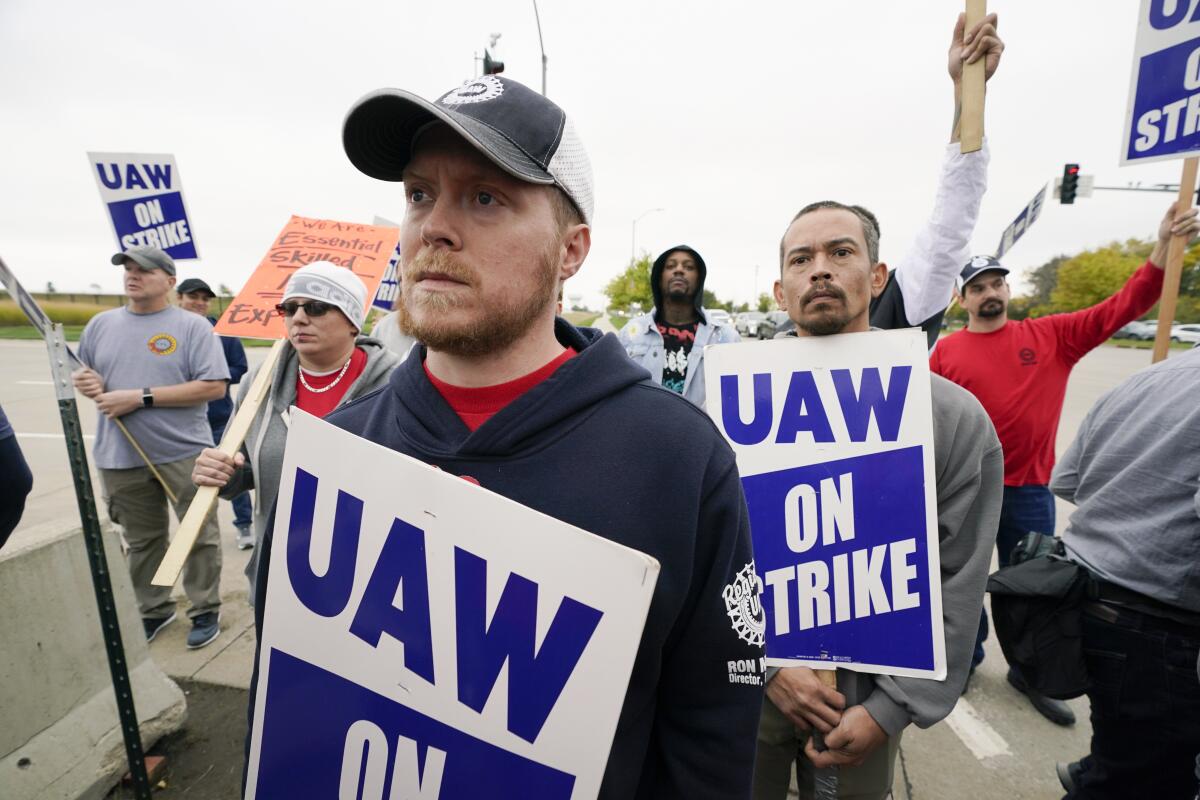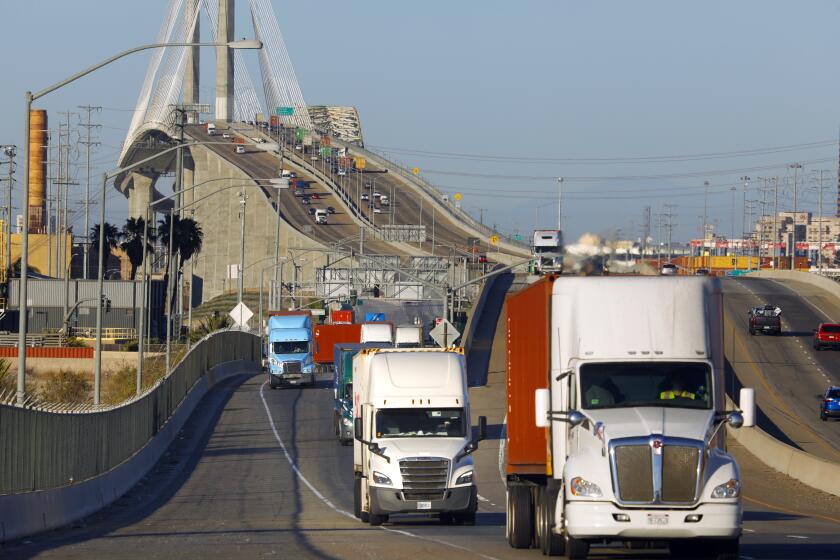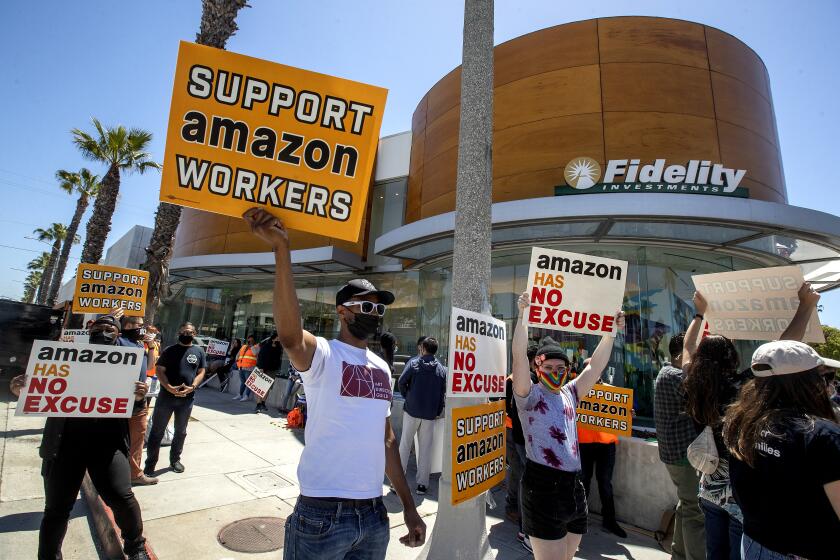Workers are fed up. But is this really #Striketober?

- Share via
When the United Auto Workers union met John Deere management last month to hash out a labor agreement for 10,000 machine workers, they thought they had a deal: a tentative contract that would give immediate raises of at least 5%, followed by 3% pay bumps in 2023 and 2025.
Union leaders said the agreement contained “significant economic gains.” But workers weren’t having it.
They knew the company was on pace this fiscal year for a record profit of nearly $6 billion. The demand for agriculture machinery is high because corn and soybean prices are up and the company is struggling to hire workers. After decades of concessions, the workers felt they had leverage.
A majority voted to reject the deal: Last week, they walked off the job at 14 assembly plants in Illinois, Iowa, Kansas, Colorado and Georgia.
“We want a fair shake, we want equity — and we don’t feel like we’re getting that,” said Chris Laursen, 51, a painter at a factory in Ottumwa, Iowa, and a former president of UAW Local 74.

For Laursen, who earns $20.82 an hour after 19 years with the company, a 5% raise amounts to just over a dollar an hour. He wants at least $5 more an hour — a raise of nearly 25% — noting that the chief executive got a 160% raise last year, bringing his total compensation up to $15.6 million.
“The timing is right,” Laursen said. “Right now, we’re seeing the cheap labor bubble burst. We’re seeing the rebirth of the American labor movement.”
Hollywood avoided a strike. But broader labor issues aren’t going away.
After decades of stagnating wages and diminishing pension and healthcare benefits, followed by a grueling 19 months working long hours during the COVID-19 pandemic, many American workers are fed up. And a small but growing number are organizing.
John Deere workers join more than 2,000 hospital employees striking in New York, along with 1,400 Kellogg workers in four states, 1,100 coal miners in Alabama, plus smaller bands of steelworkers, whiskey distillers and home healthcare workers.
In Hollywood, a strike by tens of thousands of camera operators, grips, prop makers and other film crew members that threatened to strangle the U.S. film and television studios was narrowly averted last weekend, although workers have yet to agree on a final deal. Meanwhile, nearly 21,000 Kaiser Permanente healthcare workers in Southern California voted this month to authorize a work stoppage.
But for all the #striketober hype on social media, the number of U.S. workers channeling disgruntlement into collective action is relatively tiny: 24,000 workers have gone on strike in October, according to the Cornell Labor Action Tracker, an online database set up this year to document labor protests, big and small.
So far this year, the wave of strikes falls short of the surge of worker solidarity in 2018 and 2019, when a massive wave of teachers walked off the job in states from West Virginia to Arizona, along with strikes involving thousands of private sector workers at General Motors and Marriott Hotels. According to the Bureau of Labor Statistics, more than 485,000 workers went on strike in 2018 — a nearly twentyfold increase from 2017 — and the momentum carried on in 2019 as 425,500 workers stopped work.
In 2021, one popular avenue for disgruntled workers is simply quitting: More than 4.3 million people, about 2.9% of the American workforce, left their jobs in August — the highest number in more than 20 years.
Robert Reich, a former U.S. Labor secretary, dubs the wave of resignations, mostly in hospitality, retail, and healthcare, “the General Strike of 2021.” Still, with most of the action individual rather than collective, America is far from witnessing a rerun of the 1940s, when more than 5 million workers went on strike in the months after the end of World War II to fight for better wages and working hours.
In 2021’s tighter labor market, many workers have more bargaining power than they have had for years, but they also face significant hurdles as they try to claw back past concessions and force companies to raise wages and improve working conditions.
Healthcare workers protesting staff shortages voted to authorize a strike that could affect Kaiser hospitals and clinics across Southern California.
Over the years, American workers have endured a long arc of deteriorating pay and benefits, said Heidi Shierholz, president of the Economic Policy Institute, a nonprofit research group in Washington, D.C., and former chief economist of the U.S. Department of Labor in the Obama administration.
“We’ve seen four decades of rising inequality and wage stagnation, with working people not getting their fair share of economic growth. That has laid the stage for this.”
The pandemic only exacerbated ongoing tensions. As a T-shirt worn by striking John Deere workers put it: “Deemed essential in 2020. Prove it in 2021.”
Across industries, workers face a range of pressures: wages failing to rise with inflation, declining pensions and healthcare benefits, staffing shortages, long working hours with few to no breaks.
At John Deere, workers are seeking to reverse concessions made nearly a quarter-century ago — a two-tier wage and benefit system introduced in 1997 that lowered pay, healthcare benefits and pensions for new employees. The company is trying to introduce a third tier that would replace pensions with 401(k) plans for new hires.
Kellogg workers are also fighting a two-tier system introduced in 2015, when cereals were in decline, that has new employees earning more than $10 less per hour with poorer healthcare and retirement benefits.
Dan Osborn, a 46-year-old mechanic at a Kellogg factory in Omaha, said he and his co-workers had spent the last year working 12-hour shifts and forced weekends at the plant that makes Corn Flakes and Froot Loops.
XPO Logistics, one of the world’s largest trucking companies, settled with drivers who had alleged it paid them less than minimum wage.
The company’s proposed contract, he said, was galling as its profits rose by 21% in 2020 and the chief executive received $11.6 million in compensation — 279 times more than the median employee.
Workers, he said, did not feel adequately compensated for their labor. If the company refused to overturn wage and benefit cuts in times of wealth, he argued, future waves of employees would face a bleak economic future.
“We have a lot of people who have second- or third-generation people working in the plant,” he said this week from the picket line. “We want to protect those future generations with good-paying jobs with good benefits, where people can have a livable wage and send their kids to college and live the American dream. That’s under threat.”
Kellogg disputes many of the union’s claims, saying most employees have “industry-leading pay and benefits,” with the majority earning $120,000 in 2020, and “unparalleled, no-cost comprehensive” health insurance. Most employees worked an average of 52 to 56 hours a week, it said, and 90% of the time, they volunteered for extra hours.
“The union agreed to a two-tiered system in 2015 to help address rising labor costs, which were out of sync with the market and the rest of our network,” Kris Bahner, a company spokesperson, said in a statement, noting that the company paid a $15,000 signing bonus to each hourly cereal employee in exchange for the changes. “Now the union wants to go back on that agreement.”
One of the nation’s largest healthcare providers, Kaiser Permanente, is attempting to lower wages for new hires by as much as 39% in 2023 — a move that union leaders say would deter skilled workers from entering the field at a time when existing nurses are exhausted.
“Those nurses have been working, trying to keep those patients alive, short staffed,” said Elizabeth Hawkins, a retired nurse and negotiator for the United Nurses Assns. of California/Union of Health Care Professionals. “They’re angry.”
Kaiser said in a statement that it proposed a “market-based compensation structure” to “address future costs and ensure we continue to be affordable for our members.” The system, it argued, would allow “new employees to be paid above-market wages on average; receive the same excellent, market-leading benefits; and enable us to continue attracting and retaining top talent.”
AB 701, headed to a Senate vote this week, is the first legislation in the U.S. that would regulate warehouse performance metrics.
Kaiser, which made $2.2 billion in profit in 2020, proposes to offer current nurses 1% raises for each of the next three years. Nurses are demanding 4% raises — still below the inflation rate — and a commitment to hire more nurses.
Hawkins said nurses would not strike solely because of low wage proposals, but because they are incensed about staffing, backfill and workload.
“Until the company fixes that, they are going to be ready to go on strike,” she said. “They know that if they don’t do this, staffing is not going to get any better, care is not going to get any better.”
Union leaders are hoping for a resurgence in activism.
“This is not temporary,” said Lee Saunders, president of the American Federation of State, County and Municipal Employees, AFL-CIO, which has 1.4 million members and represents more than 20,000 Kaiser nurses who voted to strike. “We’re seeing on the part of workers a new activism where they are frustrated, and they’re angry because they don’t believe that they’ve been treated fairly.”
But some labor experts warn that workers’ newfound bargaining power may not last.
“As the pandemic’s extraordinary circumstances are resolved, I think that source of worker leverage will also fade,” Shierholz said. “Under current law, the deck is stacked against a big increase in union activity.”
Amazon workers’ high-profile, but ultimately unsuccessful, union campaign in Bessemer, Ala., she said, was an extraordinary testament to the unlevel playing field between workers and employers.
Over decades, the labor movement has been weakened by a proliferation of “right-to-work” laws, which drain unions of operating funds. Twenty-eight states have enacted these laws, which forbid unions from requiring nonmembers in a unionized workplace to pay fees for the benefits they gain from collective bargaining.
With the growing strength of corporate lobbying, five new states have joined the group since 2012, including Indiana, Michigan, Wisconsin, West Virginia and Kentucky. In 2018, the U.S. Supreme Court extended right-to-work provisions to all public employee unions.
Employers regularly hold captive audience anti-union meetings to dissuade workers from unionizing and can permanently replace striking workers. Even though it’s illegal for an employer to retaliate against workers, harass them or intimidate them during union organizing, labor experts say it happens frequently because the penalties are so low.
As unions decry the failure of federal laws to protect organizing, they are focusing on bolstering worker protections in labor-friendly legislatures.
In California, unions pushed through a law, Assembly Bill 5, making it harder for companies to classify workers as independent contractors who are not able to unionize. Last month, a Teamsters-backed law in California took aim at Amazon and other warehouse operators, forcing them to disclose workplace speed quotas, which have led to high injury rates.
Labor experts wonder whether workers can employ their leverage to change the nation’s labor laws.
“Is it strong enough to build the momentum to win some part of labor law reform that would allow for greater success in organizing?” said Ken Jacobs, chair of the UC Berkeley Center for Labor Research and Education. “That’s the real question.”
Public support for unions is high. An August Gallup poll showed 68% of Americans approve of labor unions, the highest percentage in more than 50 years.
Still, workers face immense hurdles in organizing.
Union membership has plummeted over the last half-century. Only about 10.8% of U.S. workers were members of unions in 2020, compared with a peak of 34.8% in 1954, according to the Bureau of Labor Statistics.
The Protecting the Right to Organize Act, a bill passed by the House earlier this year, would help level the playing field, Shierholz said. It would require all employees represented by a bargaining unit to contribute fees for the cost of representation, thus abolishing state right-to-work laws. It would also make it illegal to replace or discriminate against workers who participate in strikes or require employees to attend “captive audience” anti-union meetings.
With little chance of Senate passage, Democrats are trying to tuck some of its provisions, such as increasing penalties on companies for unfair labor practices, into President Biden’s Build Back Better Act. The act would also allow the National Labor Relations Board to fine companies that hold anti-union captive audience meetings on the job site and hire permanent strike replacement workers.
As John Deere workers strike, the company has activated a Customer Service Continuation plan, bringing nonunion salaried employees onto the shop floor to keep operations running.
But Laursen said morale on the picket line remained high.
“This strike’s been a long time coming — and people are ready,” he said. “We’ve been telling our members to save up for years. Because it’s going to become: ‘How long can Deere not produce? How long can our striking workers stay out on the picket line? Who starves out who?’”
More to Read
Sign up for Essential California
The most important California stories and recommendations in your inbox every morning.
You may occasionally receive promotional content from the Los Angeles Times.
















